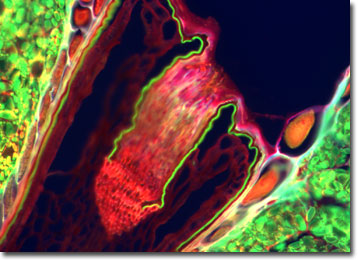Fluorescence Digital Image Gallery
Wheat Kernel
Wheat is the common name for any of the cereal grasses belonging to the genus Triticum and is an important food source for people around the world. The wheat plant is a tall annual and typically grows to a height of four feet.

The leaves, similar to those of other grasses, appear early and are followed by slender stalks that produce flowers. Flowers that are fertilized produce seeds called grains or kernels. The wheat kernel is made up of three parts: the endosperm, the bran, and the germ. The tiny germ is the part of the kernel that will sprout and grow into a new wheat plant if the seed is planted.
Wheat grains can be eaten by simply soaking and cooking the grain. The majority of food uses, however, require more processing. First, the grain is cleaned and conditioned by adding water. This causes the kernel to break up properly when it is milled. During the milling process, the grain is cracked, then flattened by rollers. This process continues and particles are sifted by size until about 70 percent of the grain has been powdered into flour. White flour contains only the endosperm of the kernel and stores longer without spoiling. Whole-wheat flour contains more parts of the kernel, the bran and the germ, which makes it healthier to eat but more susceptible to spoilage.
Evidence shows that wheat grew as a wild grass in the Middle East nearly 10,000 years ago and was in cultivation by 6,000 BC. The Egyptians were the first to discover how to make yeast-leavened breads, sometime between 3,000 and 2,000 BC. Since wheat is the only grain with enough gluten to make a raised or leavened loaf of bread, it was quickly favored over other grains grown at the time, such as oats, millet, rice, and barley.
The specimen presented here was imaged with a Nikon Eclipse E600 microscope operating with fluorite and/or apochromatic objectives and vertical illuminator equipped with a mercury arc lamp. Specimens were illuminated through Nikon dichromatic filter blocks containing interference filters and a dichroic mirror and imaged with standard epi-fluorescence techniques. Specific filters for the wheat kernel tissue stained thin section were a UV-2E/C, B-2E/C, and a Y-2E/C. Photomicrographs were captured with an Optronics MagnaFire digital camera system coupled to the microscope with a lens-free C-mount adapter.
BACK TO THE FLUORESCENCE DIGITAL IMAGE GALLERY
